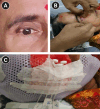Implementing high-dose rate surface mould brachytherapy for carcinoma of eyelid: a practical approach and weekly review
- PMID: 38946078
- PMCID: PMC11215503
- DOI: 10.3857/roj.2023.00682
Implementing high-dose rate surface mould brachytherapy for carcinoma of eyelid: a practical approach and weekly review
Abstract
Surface mould brachytherapy is a conformal radiotherapy technique that can deliver high dose to the target while sparing nearby normal structures, Here, we aim to describe the procedurals details for high-dose rate (HDR) surface mould brachytherapy in sebaceous carcinoma of eyelid in a 54-year old lady. She was hesitant for surgery and any form of invasive intervention like interstitial brachytherapy. So, she was treated with surface mould HDR brachytherapy to a total dose of 52 Gy in 13 fractions at a dose of 4 Gy per fraction delivered twice daily using Iridium-192 isotope with no acute side effects. She was evaluated on a weekly basis for any radiation side effects and now she is disease-free for 6 months post-treatment with only mild dry eye. A detailed step-by-step procedure of surface mould technique, simulation procedure, dose prescription, planning, plan evaluation and treatment has been described in this paper. Surface mould HDR brachytherapy can be safely used as organ preserving modality of treatment for eyelid carcinoma.
Keywords: Brachytherapy; Eyelid carcinoma; High-dose rate; Sebaceous carcinoma; Surface mould.
Conflict of interest statement
No potential conflict of interest relevant to this article was reported.
Figures




References
-
- Yin VT, Merritt HA, Sniegowski M, Esmaeli B. Eyelid and ocular surface carcinoma: diagnosis and management. Clin Dermatol. 2015;33:159–69. - PubMed
-
- Deprez M, Uffer S. Clinicopathological features of eyelid skin tumors: a retrospective study of 5504 cases and review of literature. Am J Dermatopathol. 2009;31:256–62. - PubMed
-
- Silverman N, Shinder R. What's new in eyelid tumors. Asia Pac J Ophthalmol (Phila) 2017;6:143–52. - PubMed
-
- Cook BE, Bartley GB. Treatment options and future prospects for the management of eyelid malignancies: an evidence-based update. Ophthalmology. 2001;108:2088–98. - PubMed
Publication types
LinkOut - more resources
Full Text Sources

